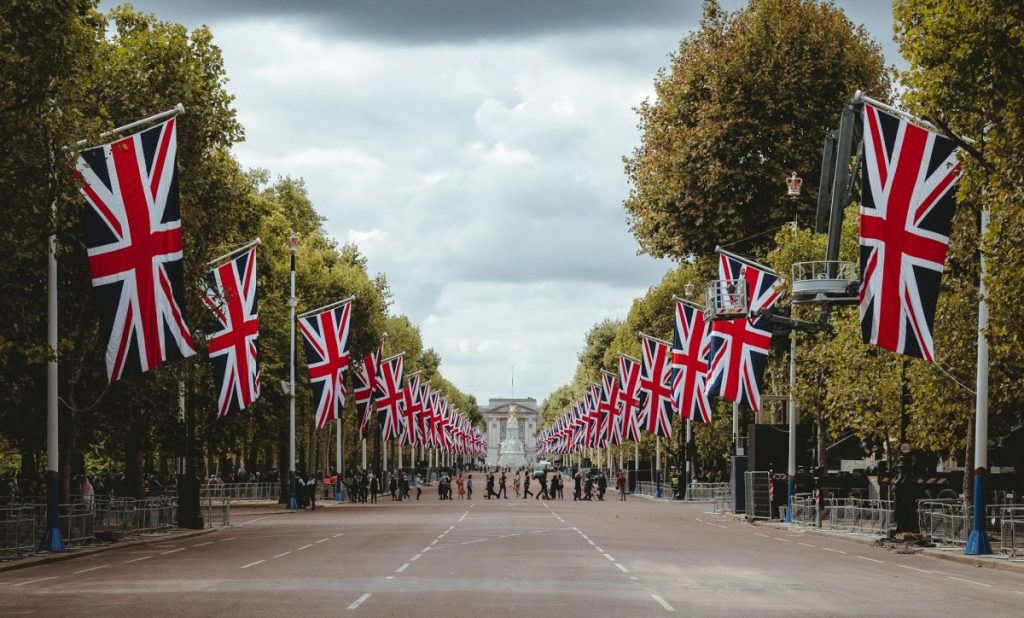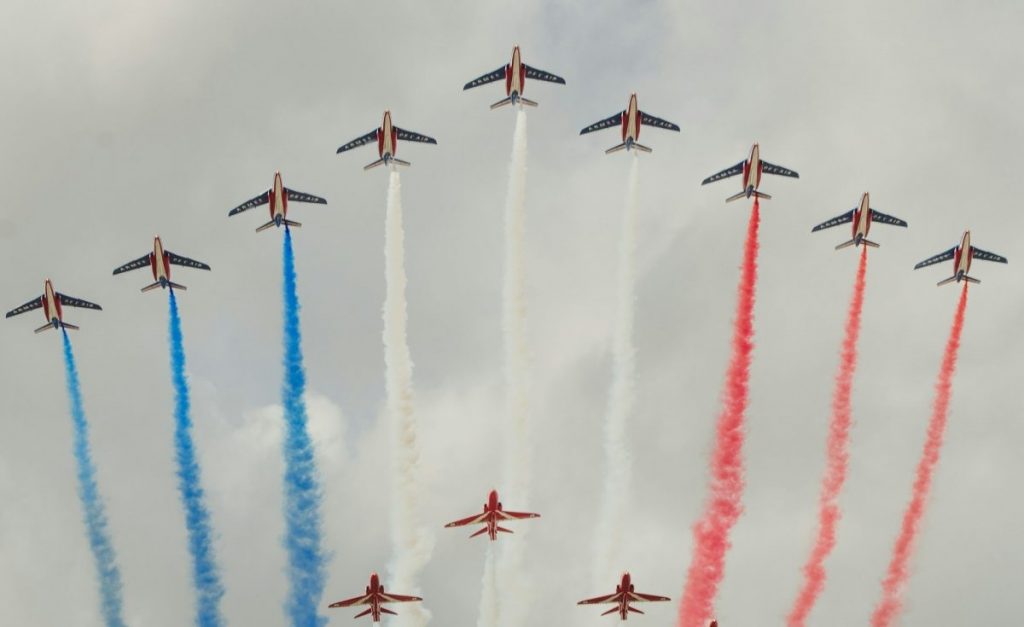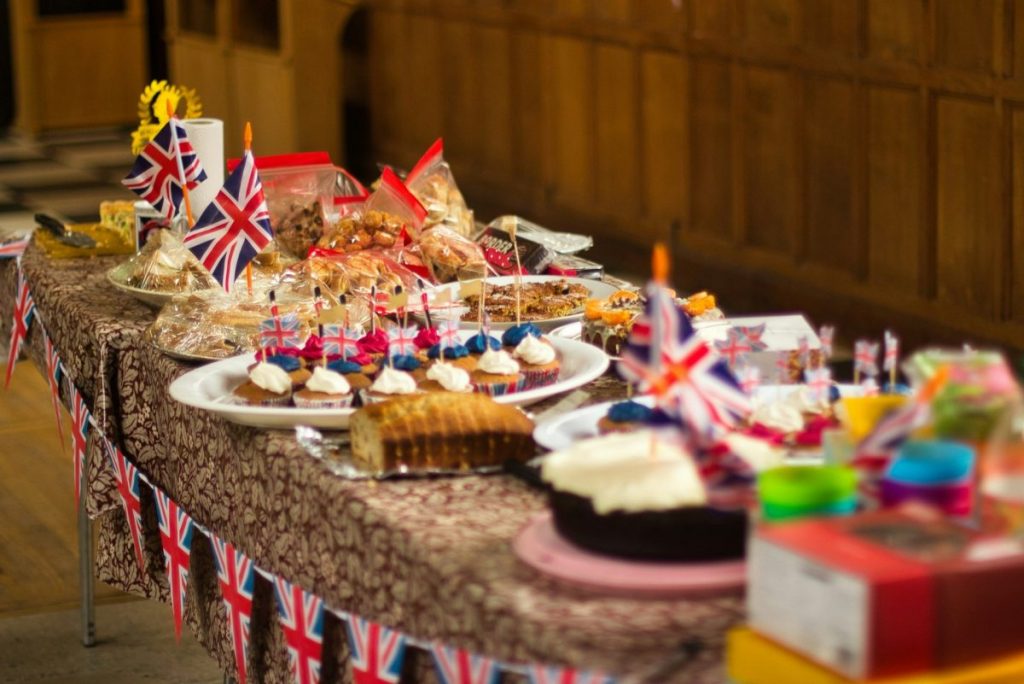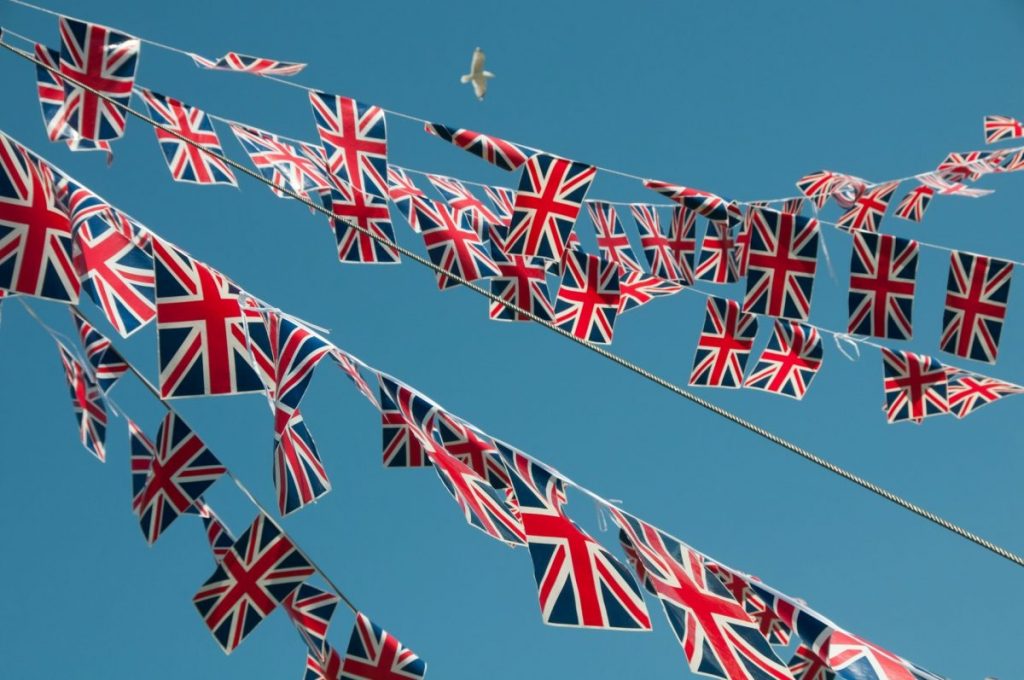 The Union Jacks have been unfurled across the UK in preparation for VE Day on 8th May. This year the event marks the 80th anniversary of the end of the Second World War. London is getting ready for a spectacular event on Bank Holiday Monday to kick off four days of celebrations, which will include a procession ending at Buckingham Palace and flypast by the Red Arrows. We’ve created an EFL lesson for the occasion. Let’s explore…
The Union Jacks have been unfurled across the UK in preparation for VE Day on 8th May. This year the event marks the 80th anniversary of the end of the Second World War. London is getting ready for a spectacular event on Bank Holiday Monday to kick off four days of celebrations, which will include a procession ending at Buckingham Palace and flypast by the Red Arrows. We’ve created an EFL lesson for the occasion. Let’s explore…
On 8th May 1945, the Second World War ended in Europe. This day became known as VE Day or Victory in Europe Day, marking the official surrender of Nazi Germany to the Allied forces. People across Europe and the world celebrated the end of nearly six years of war.
Read on to explore our ideas for a VE Day English lesson, including brief history, vocabulary, grammar points and discussion points. We have a word match challenge, writing task, chat about tenses and quiz questions, all perfect for creating an engaging VE Day EFL lesson!
What is VE Day?
VE Day stands for Victory in Europe Day. It is celebrated on May 8th to mark the end of World War II in Europe in 1945. On this day, people in Britain and many other countries remember the moment when Nazi Germany officially surrendered, bringing years of war to a close.
The day is important because it celebrates peace, freedom and the bravery of those who fought. It also reminds us how difficult the war was, allows us to give thanks to those who suffered for the freedom of future generations, and why it’s so important to remember history so we can build a better future.
What is the Difference Between VE Day and Remembrance Day?
VE Day happens on 8th May and commemorates the official end of World War II (WWII) in Europe in 1945. VE Day is about celebrating peace and victory in Europe.
Remembrance Day falls on 11th November and commemorates the end of World War I in 1918. This day honours all soldiers who have died in war, not just in WWI but in other conflicts too, including WWII. Remembrance Day is about remembering the fallen.
WWII history in brief
World War II began in 1939 when Germany, led by Adolf Hitler, invaded Poland. Soon, many countries were involved, including the United Kingdom, France, the Soviet Union and the United States.
The war caused great suffering: cities were bombed, families were separated and millions of people died, including soldiers and civilians.
By early 1945, Germany was losing the war. On 30 April 1945, Hitler died in Berlin, then one week later, German leaders officially agreed to surrender. The next day, 8 May, was declared VE Day.
Celebrations around the world in 1945
In the UK, VE Day was a moment of relief and joy. Millions of people celebrated in the streets. There were parties, music, dancing and speeches. Prime Minister Winston Churchill gave a famous speech, thanking the British people for their courage and determination.
In London, crowds gathered at Buckingham Palace to see the Royal Family wave from the balcony.
In the United States, where it was still 7th May due to the time difference, people also celebrated. In France, the Netherlands and many other countries, people lit candles and held parades.
A Moment of reflection – the aftereffects of WWII
Although VE Day was a time of happiness, it was also deeply emotional. Many families had lost loved ones, cities were damaged or destroyed, while food and supplies were limited. While the war in Europe was over, the conflict in Asia continued until August 1945, when Japan surrendered.
Today, VE Day is still remembered in many countries. In the UK, people hold ceremonies and events to honour those who fought and those who died. It is a time to remember the past and think about the importance of unity, peace and freedom.
VE Day reminds us that war affects everyone. It shows the value of cooperation between nations and encourages us to be thankful for peace.
The message that we should never take peace for granted will be with us over these four days of celebration and reflection.
This is especially significant at the moment as we live with the uncertainty of the war in Ukraine and in the Middle East.
How is the VE Day anniversary celebrated?
VE Day is marked with:
- Two-minute silences to remember those who died
- Official events such as the procession in London and flypast by the Red Arrows (the Royal Airforce Aerobatic Team) over Buckingham Palace
- Veterans sharing their stories
- People waving Union Jack flags and decorating houses and buildings with red, white and blue bunting
- Community events, parades and street parties
- Singing songs from the 1940s like “We’ll Meet Again” and dancing in styles such as Swing and Jazz, and learning dances like the “Lindy Hop”, which were popular in the 1940s
- Church services to give thanks for peace and remember those who died
In 2025 on the 80th anniversary of VE Day, there will be four days of celebrations across the UK, starting on 5th May, Bank Holiday Monday.
On 5th May in London the event kicks off with actor Timothy Spall giving Winston Churchill’s victory speech. The procession then starts from Parliament Square, travelling along Whitehall and The Mall, and finishing at the Queen Victoria Memorial.
The Cenotaph, a national war memorial on Whitehall, will be draped in Union flags (also called Union Jacks).
There will be a spectacular flypast by the Red Arrows (the RAF Aerobatic Team) over The Mall and Buckingham Palace, turning the sky red, white and blue. Later in the afternoon there will be a gun salute.
The whole event in London on Bank Holiday Monday will be screened on television for anyone who wants to celebrate from home, enjoy the procession, see the Royal Family on the balcony of Buckingham Palace, and watch the Red Arrows display.
Later in the week we will see an installation of red poppies at the Tower of London, an anniversary concert by the Parliament Choir at Westminster Hall, and a thanksgiving service at Westminster Abbey on 8th May, VE Day.
VE Day EFL Lesson Plan
These VE Day lesson ideas introduce learners to an important historical event while building vocabulary, cultural awareness, writing skills and speaking skills. Teachers can enhance a VE Day lesson with WWII-era music, photos and video clips.
Here are some EFL lesson ideas to explore vocabulary and some ideas for a discussion to help students practise their speaking skills and listening skills:
VE Day Vocabulary
Useful vocabulary related to VE Day:
to surrender – to officially stop fighting and accept defeat
Allied – forces the group of countries (e.g. UK, USA, USSR) fighting against Germany
destruction – serious damage or ruin
relief – a feeling of comfort after stress or fear
troops – groups of soldiers
parade – a public celebration with people marching, music, and flags
determination – the will to keep trying despite difficulties
civilians – people who are not in the military
ceremony – a formal event to remember or celebrate something
unity – being joined or working together as one
surrender – to officially stop fighting and give in (to allow the other side to win)
veteran – a person who fought in a war
the fallen – a respectful way to describe people who died in war or battle
commemorate – celebration to remember something important
freedom – the ability to live without control by others
Word Match Challenge
Students can match the following words to their meanings, using the vocabulary list above. They could draw a line from the word to the correct definition:
a) Surrender A respectful way of describing people who died in war
b) Veteran The ability to live without control by others
c) Commemorate To officially stop fighting and give in (to allow the other side to win)
d) The Fallen A celebration to remember something important
e) Freedom A person who fought in a war
Comprehension Questions:
Ask students these questions after they have read about VE Day to test their comprehension. They could speak the answers aloud or write them down:
- What does VE Day stand for?
- What happened on May 8th, 1945?
- Why is VE Day still important today?
- Name two ways people celebrate VE Day.
- What kind of songs are sung on VE Day?
Writing task: Imagine you were there
Ask students to write a short paragraph pretending they were alive on VE Day in 1945. They should consider reflections on how they would feel and what might they see or hear during the day.
Discussion Questions
Encourage students to work in pairs or small groups to share their thoughts on VE Day. Some questions to have students ask each other and to think about or write about:
- Why do you think people were so emotional on VE Day?
- How do you think people felt who lost family members in the war?
- Are there any special days in your country that celebrate peace or freedom?
- Do you think it’s important to remember events like VE Day? Why or why not?
- If you had lived during World War II, what do you think you would have found most difficult?
- What lessons can young people learn from the history of VE Day?
- Do people in your country celebrate any similar days?
- What does “freedom” mean to you?
VE Day Grammar Points
Tenses: Past Simple vs. Past Perfect
Highlight how this page uses different tenses to express time relations. We use the simple past for the main events, and the past perfect for things that happened before them.
Example:
“The war ended in 1945.” (simple past)
“Millions of people had died.” (past perfect here uses “had” to show it happened before the war ended)
Activity Idea: Ask students to underline examples of each in the text, then write two of their own sentences about a historical event.
Passive Voice (Past Tense)
Used to focus on the action or result rather than the person doing it.
Example:
“German leaders officially agreed to surrender.”
“VE Day was declared.”
Practice: Rewrite a few active sentences from the article into the passive voice, or vice versa.
- Note: The passive voice is often used to mask the responsibility or culpability of someone committing the act in the sentence (e.g. “The cake was stolen” instead of “The thief stole the cake” – this removes responsibility grammatically from the thief and puts the focus onto the cake, not onto the person who stole it).
Time Linkers
Used to show the order of events: “By early 1945,” “One week later,” “Today,” “After years of…”
Activity: Students can write a short paragraph about a celebration or historical event in their country using time linkers.
VE Day Conversations in the Classroom
VE Day isn’t just a moment in history—it’s a powerful way to connect language learning with real human stories. Through lesson ideas like these, students can build their vocabulary and grammar skills, while exploring important themes like peace, courage and resilience.
Lessons like this VE Day EFL lesson plan show that language is about more than just rules and words—it’s about understanding the world.
Share your thoughts on VE Day
- Teachers, how would you adapt this VE Day English lesson for your students?
- Have you ever taught historical topics in your EFL classroom? How did your learners respond?
- What other real-world topics do you enjoy using to teach English?
- What challenges do you face when discussing emotional or complex topics with English learners?
- Students, which lesson ideas did you enjoy the most?
- Which new words or grammar points did you learn today?
- Did you find any parts of the article difficult to understand?



